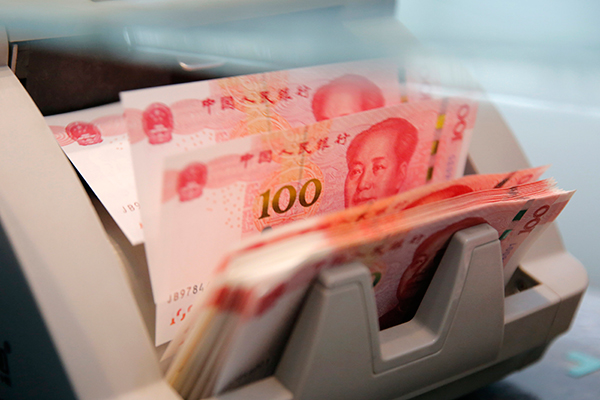Solid banks, hurt, will ride out epidemic to emerge versatile


Since the beginning of this year, COVID-19 has had a negative impact on the Chinese economy and disrupted normal functioning of society. It has also brought new uncertainties to China's banking sector.
The impact will likely prove short-term. As China began implementing a series of policies, banks swung into action in the virus battle. The development of the banking sector should hopefully remain resilient.
The Chinese banking sector has global lead in cost effectiveness. It also has tremendous capital strength, which should help the sector to ride out the epidemic and head toward high-quality development.
There could be the rising pressure of nonperforming loans relating to industries that have a mass quotient, like catering, tourism and transport. We may also see a decline in the debt repayment capacity of small businesses, farmers, and people who have a flexible work schedule, and increasing defaults at small-and medium-sized real estate companies.
It will take some time for the banking sector to deal with the pressure on asset quality brought by the epidemic, against the backdrop of a slowdown in economic growth that was at high rates so far.
Although commercial banks may face higher pressure on asset quality this year, their capabilities of risk compensation still remain strong.
According to data from the China Banking and Insurance Regulatory Commission, commercial banks made a combined net profit of 2 trillion yuan ($285 billion) in 2019.
At the end of the fourth quarter last year, the loan loss provision coverage ratio of commercial banks was 186.08 percent and the capital adequacy ratio was 14.64 percent.
These figures reached a relatively high level in the last few years, showing that the banking sector still has strong capabilities of risk compensation to cope with potential risks.
After the COVID-19 outbreak, regulators instructed banks to provide financial services at favorable interest rates to the regions, industries and companies that are hard-hit. This will lower the average net interest margin for banks.
The epidemic will also cause a sharp fall in cash deposits and withdrawals, the credit card business, and payments and settlements associated with hotels, restaurants, cinemas, malls, tourist attractions and public transport.
As a result, banks will face challenges in terms of profitability in the short term, but the epidemic's impact on the banking sector's full-year net profit will be limited.
Whenever the epidemic subsides, the financial needs of people will increase gradually, partly because of the easing of China's monetary policy and the various measures taken to support the real economy. This will be conducive to the resumption of growth in banks' operating income at the previous rate, most probably after the second quarter.
We estimate that the banking sector will increase loan issuances and further step up support for the real economy, the part of the economy that produces goods and services.
Although the monetary policy has been relatively loose recently, it may return to normal later this year, considering that China's macro leverage ratio is relatively high and the country faces inflation pressure.
Owing to these factors, there is a fairly huge room for growth of commercial banks' total assets in the first half of this year, especially in the second quarter, but the growth will likely slow in the second half.
Before assessing the impact of COVID-19 on the Chinese banking sector, we reviewed the impact of SARS of 2002-03.
Studies found that the impact of SARS on the banking sector did not last long, although China's economic growth was temporarily affected and the profit growth of some companies in certain industries dropped significantly for a short period of time.
With the support of active macro-control policies during that period, the economy stabilized and brought new growth-drivers to the banking industry. The sector's operating income and interest income grew in pace with its total assets, which increased rapidly.
It is also worth noting that a major initiative to improve the functioning of China's banking sector started in late 2003.
After going through a series of efforts, including restructuring, initial public offerings, strengthening of corporate governance, optimization of business models, and deepening of management reforms, the Chinese banking sector maintained steady growth and developed into the world's largest banking market, with lead in the core indicators of regulatory governance.
The banking sector's current priorities are the epidemic prevention and control, the stabilization of economic growth, and the optimization of management.
The People's Bank of China, the central bank, along with other ministries and financial regulators, rolled out 30 policy measures. These injected sufficient liquidity into the country's financial markets. It also instructed commercial banks to offer favorable lending rates to companies actively engaged in the fight against the epidemic. Among the measures used were monetary instruments like the medium-term lending facility and a re-lending program of the central bank.
Under the guidance of financial regulators, banks cut lending rates, offered loan extensions, and increased the issuance of credit loans and medium-to long-term loans to small businesses that have high growth potential but face temporary difficulties because of the epidemic.
Banks also greatly improved the efficiency of financial services offered to companies involved in epidemic control and emergency response, and strengthened mobile banking and PC-based online banking services to help clients avoid paying unnecessary visits to bank branches.
Moreover, a growing number of banks have realized the importance of contactless business operations and contactless financial services.
Increasingly diversified online services will likely be launched, for faster growth of smart bank branches and smart bank counters.
With the help of financial technologies and wide cross-sector collaboration, commercial banks will build an open banking ecosystem spanning government affairs, people's livelihoods, education, healthcare and cross-border services. Financial services firms will offer clients comprehensive as well as customized solutions.
More and more banks will transition to flexible organizations whose services will be prompt, timely, responsive or swift. They will be more capable of quickly and correctly adapting to changes in market environment and client behaviors.
Zhang Xingrong, lead writer of this analysis, is the managing director of the Bank of China Research Institute in Beijing.
Co-writers Shao Ke and Liang Si work as a senior analyst and a postdoctoral fellow, respectively, at the institute.




































